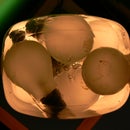Introduction: Cable: MintyBoost to Samsung D*00 Cell Phone
Samsung D series cell phones have some problems with USB charging, which cause them to not work with the excellent MintyBoost USB charger (Edit: This may be on faulty phones only, with broken ICs. Reports of these kind of problems stretch back to the D500, but are clouded by forum chatter).
This cable will enable you to charge a D series samsung from the minty (Tested: D900, Should Work: D800, D820, E780, E870, P300, P910, P920, T809, Z540, according to pinouts.ru).
The method is a little crude, but it should work for earlier D*00 models should they present similar problems. Get the right charger though; they have 18 pins out instead of 20.
Step 1: Tools, Materials, and Background.
Tools and materials:
Soldering Iron
Solder
Wire Strippers
Heatshrink tubing
Third hand tool
Type A male USB connector (Cannibalised from spare lead)
Spare mains charger for phone
I found that a D900 would not charge from a properly assembled MintyBoost, and this vexed me. The poor battery life when using it as a DAP was the main reason I got a Minty :/
It would charge for three seconds, then stop. Doing this with the phone powered down elicited the message "USB Charging Not Available", even though the presence of the 5 volt USB power was causing the screen to stay powered on.
Some Samsung phones have problems charging via USB, even though they're supposed to be able to. Reasons for this in forum chatter range from faulty ICs to incompatability with USB 1.1 hosts.
The MintyBoost simulates a USB 1.1 host with a 3.3v pull up on D-, putting the pullup on D+ causes it to appear as a USB 2.0 host.
First step was to scavenge USB parts and make a dongle, with which I could swap pins around. Making the mintyboost appear as a USB 2.0 host didn't make any difference. I also found that with the USB 2.0 ports on my desktop PC, the phone would give a charging indicator perpetually, but in fact not be charging at all. Mains chargers work just fine, but USB power is screwed.
Grr! Silly Samsung. Should be simple!
Step 2: Pinouts
You can find the pinout for recent D-Series phones here.
Initially, I though I could make a lead up out of scavenged parts, but that turned out to be impractical: The connector is about 1cm long, and has 20 pins in it. Furthermore, the plugs tend to be filled with injection molded plastic, making it a difficult job to get in without inflicting a lot of damage.
Additionally, different devices have different pins in the connector. Three are shown in the pictures below: 1. Mains charger, 2. Standard D900 USB cable, 3. Handfree kit / headphones.
Notice how the mains charger and the USB cable don't use the same pin config. The handsfree has all 20 pins in there, which would be a nightmare to pull apart and resolder. You can see my attempt to dismantle in in the fourth photo; if I kept going there wouldn't be much left to reassemble.
There's just no practical way of making up a cable with the tools and skills I have, so I order a spare mains charger from eBay: They have a 5V output, just like USB, yet the phone accepts it without any fuss. Maybe if I hook one of those plugs up to the USB 5V and ground, it will work...
I browse the pictures and select one with a plug that looks like it clips shut, rather than an injection molded one. That way, it will be easier to poke around inside and modify it if I need to.
Step 3: Make Cable
Snip the cable off the mains charger at a convenient length, then strip the two wires and tin them.
Likewise, cut the USB connector off the lead, disassemble it, trim down the D- and D+ wires, then strip and tin the live and ground ( USB in a nutshell ).
Before soldering, cut appropriate lengths of heatshrink to insulate the soldered connections from each other and also sheath the whole thing.
Solder up, shrink the tubing (The vent on a gas powered soldering tip is also really handy for that), and reassemble the USB plug.
Step 4: Test & Done
It works. Of course, it's no good for data (there's bluetooth anyway).
The tests shown here are done with the phone powered down (The charging behaviour is identical with it powered up, but the display is different).
The default USB cable results in the error shown in the second picture: "USB Charging Not Available". This is really annoying, because connection to USB power causes the display to power up and stay on while connected, but something in the phone won't let it charge the battery.
The hacked cable, which applies the 5V USB power to the same pins a mains charger would supply, simply gives "Charging". It can power the phone from any USB port.
Woo :)













